Penguins Penguins Everywhere!
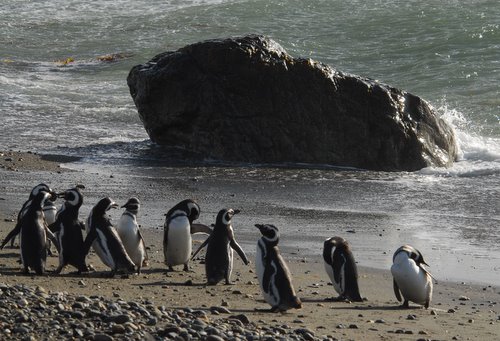
When we disembarked the MS Prinsendam in Punta Arenas, Chile the winds were howling at speeds close to 100 km/hour! The ocean was a sea of whitecaps and the seabirds were being blown around at the will of the gusts. This is undoubtedly the windy part of the continent! A new guest lecturer was boarding the Prinsendam for the sector down to Ushuaia, Argentina (in Tierra del Fuego) and on to Antarctica so my friend Trish and I arranged to do an overland jaunt across the Patagonian region of Chile and then up to Iguazu Falls, on the border between Argentina and Brazil.
About an hour’s drive from the town of Punta Arenas, Chile at Otway Sound, is a readily accessible penguin colony which we wanted to visit… so we booked transport and away we went. What a fabulous opportunity!
There are seventeen species of penguin in the world, and they live exclusively in the southern hemisphere. The one species that is a slight exception to this rule is the Galapagos Penguin which nests just north of the equator on one of the islands of the Galapagos Islands archipelago (off the coast of Ecuador). The Emperor Penguin, the species that was made famous by the fabulous film, “The March of the Penguins”, is the species that nests closest to the South Pole (and the Emperor is also the largest and heaviest penguin) while most species breed at more agreeable latitudes.
Through my travels I have had the good fortune to see penguins in other parts of the southern hemisphere including New Zealand, Australia and South Africa, but apart from the Galapagos Penguins (which I saw last year in the Galapagos Islands) these Magellanic Penguins were my first South American tuxedo birds.
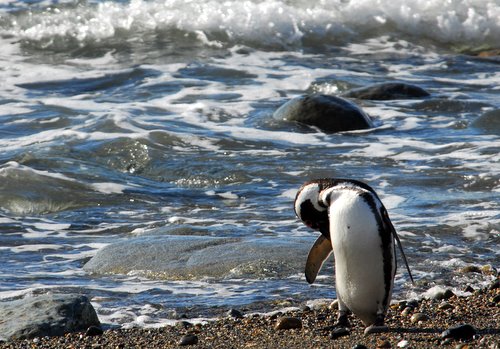
It was such a treat to watch the adults body surf their way to shore, ride the waves, manoeuvre their bodies and slide into shore (sometimes tumbling and crashing into shore). Once safely on land the first thing they would do is preen (clean) their feathers (penguins spend a lot of their time taking care of their feathers). Then they make their way across the beach, and finally march one by one across the grass to find their burrows and to feed their young.
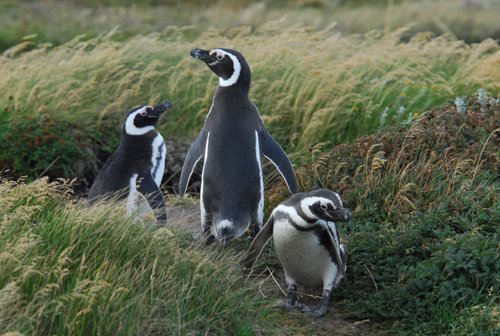
The Magellanic Penguin is a common summer resident in Patagonia. Their breeding grounds are scattered along the southern Atlantic and Pacific coasts of Chile and Argentina. They also have important breeding colonies in the Falkand Islands (Islas Malvinas). This Otway Sound colony has an estimated population of about 4000 birds.
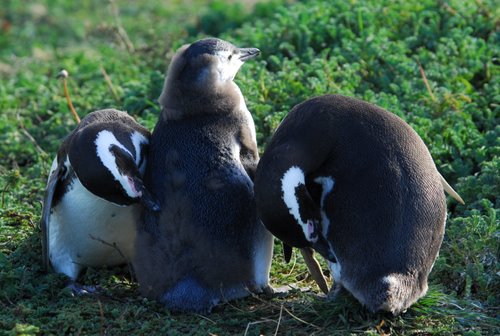
The penguins are here to breed. The cycle begins in September and lasts until March. Being late January now, the chicks are getting bigger and they need a lot of food. To satisfy their hearty appetites the adults must go out to sea frequently to forage. There key food items include squid, prawns and a range of small schooling fish (jack mackerel, anchovies & sardines). These are the very same species that are presently being harvested in huge quantities off the coasts of Chile, Peru and Ecuador to feed the needs of the fish farming industry. These small pelagic fish are processed into fish meal, which is then used to feed the salmon and trout being raised in fish farms in different parts of the world including British Columbia. If you want to read more about the relationship between penguins, pelagic fish and fish farms, read my previous Blog post.
Hello and thank you so much for your message. I am really pleased to know that you and your class are following the journey. I have added some more photos to the Penguin post so I hope you enjoy them. If you have any questions, please feel free to ask and I will do my best to answer them.
Cheerios
Danny :)
Hi there Laura,
Sorry for my delay in resonding to you. Yes, I am checking my email when I can and also trying to keep up with the blog too (I am a bit behind) ... but all is good. Thanks so much for the URL link, I appreciate it (I have not had a chance to check it yet but will do so). Thanks again for your messages ... and do drop me a note (with a pic or two) when you have a moment.
Cheers, Danny :)
Hi Jill, Many thanks for your note. I am doing a bit of filming and hope to get some short snippits up on the blog soon. The penguins were fabulous.... and I hope to see lots more in Antarctica in a week or so. I hope all is well back in the hood!
Cheerios, Danny :)
I found some pics that you should see about the greast Incas heres how to get them go to google and typ (the great inca) and go to the frist one on the page. You should put on your bloges and right more about them because my friend Emily Freaser (she sent you an e-mail to) are doing a porject onn the incaes that woold help me alot
your freind hannah marks (gread 5 my teacheres name is Jill French)
Hello Hannah!
Thank you for your message. I will definitely do an internet search as you suggest to see more photos related to the Incas. I have just returned from a visit to Antarctica so I apologize for the delay in getting a message to you. I hope your project on the Incas was a great success (I assume you have it done by now). Keep posted as I will add more photos and post soon about my journey to Antarctica.
Cheers, Danny
Dear Mr. Catt,
We are the COAST class blogging together today. We are enlightened by your trip and enjoy seeing and experiencing it with you through your pictures. We particularly liked the photphraphs of the penguins and we were wondering how close you could get to them. We realize you have a zoom lens but we would like to know about the habits of the penguins in relation to human beings.
We look forward to more blogs,
The COAST class :)
Hello to the Coast Class!
I apologize for my delayed repsonse to your hello. I have recently returned from Antarctica and I am trying to catch up with posts and uploading photos etc. I am really pleased that you are following along and I hope you will enjoy some of the new penguin pics (from Antarctica) which will be up soon. At the colony in southern Chile (the pictures you are referring to) visitors are not permitted to get close to the penguins (there is a boardwalk and/or trail that you must stay on). There are also signs indicating that visitors must not disturb the penguins as they go about their routine (tromping across the beach and grass to feed and take care of their chick). The photos make it appear I was really close to them, but that is where a good telephoto lens helps immensely! Thanks again for your hello... and do send more questions if any come to mind.
Cheers
Danny
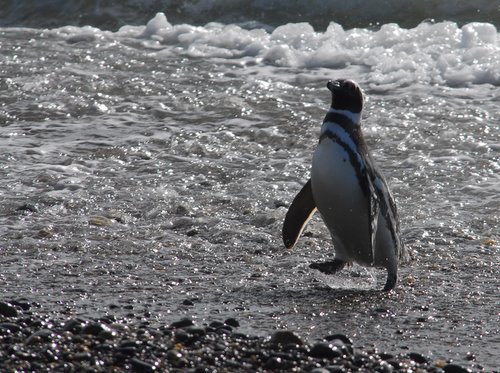
 Funded by TEK
Funded by TEK